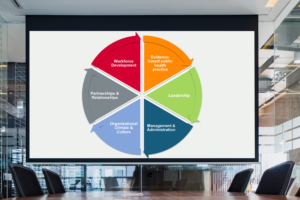NACDD hosts a variety of self-paced virtual courses for chronic disease directors, emerging leaders, and practitioners.
Topics include public health leadership development, workplace tools, advocacy, and more. Here is full list of courses can be accessed in the NACDD Learning Center.
Learners will need register or login at learn.chronicdisease.org to access courses.
NACDD Online Learning Center Catalog
Generations Working Together in Public Health
This learning module focused on helping you become more knowledgeable about key differences between the three most common generations in the public health workplace: Boomers, Gen Xers and Millennials, and gain an appreciation for each generation’s strengths and uniqueness. With more understanding about each generation, you can better work together to achieve public health goals without conflict or misunderstanding.
By the end of this NACDD learning module, you will be able to:
- Explain why working closely with other generations can help you better achieve your public health goals.
- Describe the generational demographics of those working in public health.
- Identify the characteristics of various generations – including their values, strengths, and challenges.
- Determine new ways to approach and work with those of different generations – both inside and outside of public health.

Leadership Basics: Budgeting
Budgets are a necessary component of all chronic disease programs. Before you begin developing a budget, understanding the funder and their funding process can be useful. This brief lesson provides context for the federal budget process that drives many chronic disease programs; distinguishes federally-funded budgets from common state and private philanthropic budget requirements; and lists resources for learning more about federal and state budgeting processes. A brief summary of best practices for budgeting for chronic disease prevention programs is also provided.Upon completion of this learning opportunity, the participant should be able to:
- Describe the federal budget process that funds CDC.
- Compare and contrast the federal budget process from state budget processes.
- Identify places to seek additional information regarding budgeting and managing budgets associated with CDC cooperative agreements.
Leadership Basics: Change Management
Change management frameworks provide a structured approach to managing change initiatives and quality improvement activities within organizations. This module defines change management and provides an overview of several change management frameworks and related models. The module also provides an example of how to apply one of the leading change management frameworks to a change initiative in a state health department.
Upon completion of this course, you will be able to:
- Define change management.
- Describe at least two frameworks or theories related to change management.
- Articulate why change management and change leadership are important within public health practice.
- Apply change management principles to real-life public health work.
Leadership Basics: Design Thinking
Developed by David Kelley, the founder of IDEO, design thinking is defined as “a human-centered approach to innovation that draws from the designer’s toolkit to integrate the needs of people, the possibilities of technology, and the requirements for business success.” The approach appears well-suited for addressing issues of population health. It can also be a leadership philosophy, and this module provides further detail to support the application of design thinking.
Learning Objectives:
Upon completion of this learning opportunity, the participant should be able to:
- Explain the value of design thinking.
- Apply design thinking to the context of public health.
- Explain how design thinking can be applied to leadership.
Leadership Basics: Emotional Intelligence
Chronic disease prevention and control is a rapidly changing field, and one that relies on transdisciplinary approaches and professionals and stakeholders from a variety of backgrounds working together. It can be a very satisfying and fulfilling field of work and, at the same time, stressful. In this brief lesson, the relationship between emotional intelligence and job satisfaction is explored. There are different types of intelligence, and emotional intelligence is one type that can be used and expanded. Emotional intelligence can also reduce stress through a greater understanding of, and response to, others and one’s own experiences.
Upon completion of this learning opportunity, the participant should be able to:
- List the different types of intelligence.
- Summarize the role of emotional intelligence in leadership and management.
- Explain the link between emotional intelligence and job satisfaction/happiness.
Leadership Basics: Equity
Embedding equity within formal and informal leadership structures is a foundation for organizational capacity and readiness to take action on health inequities. Discover ways to incorporate an equity lens in the daily work of a chronic disease unit.
Learning Objectives:
Upon completion of this learning opportunity, the participant should be able to:
- Demonstrate ability to implement strategies to promote health equity and investing the resources to that end
- Demonstrate ability to apply an equity lens to the development, execution, and evaluation of public health programs
Leadership Basics: Facilitation
Facilitation is a key skill for anyone who works in chronic disease prevention or control. It is a skill nearly all of us call on every single day, whether it is facilitating a large group of stakeholders or navigating a small meeting with peers. Good facilitation can help to create a shared vision for a program or policy; poor facilitation can quickly take a project or a meeting down the wrong path. In this brief course, a top 10 list of facilitation tips and tricks is described. This list of suggests or approaches to try is intended to offer a menu of ideas the participant can put into practice immediately in common situations in chronic disease prevention and control programs, as well as some potential pitfalls to avoid.
Upon completion of this learning opportunity, the participant should be able to:
- Identify scenarios where facilitation may be a helpful tool
- List some strategies for facilitating difficult conversations
Leadership Basics: Leadership vs. Management
Many people confuse the terms management and leadership, using them interchangeably or believing that not all managers are leaders, or that leadership is elusive and only found in a few special individuals. Management and Leadership are two different concepts as this module explains; both are important to all organizations.
Upon completion of this learning opportunity, the participant should be able to:
- Define management and leadership.
- Distinguish between management and leadership roles.
- Apply leadership vs. management skills to issues chronic disease units currently tackle.
Leadership Basics: Leading Through Change
In chronic disease prevention and control, it is common for staff at all levels to be asked to lead through, or during times of, change. Sometimes the change is generated by external forces outside of our control that require changes in programs, personnel or internal practices, and other times change is a necessary component of an intervention we are applying, like policy change in an organization or community. In this brief course, a high-level overview of key strategies and potential approaches for supporting others during times of change is offered. This course offers practical suggestions that can be applied in chronic disease units within state and local health departments.
Upon completion of this learning opportunity, the participant should be able to:
- Identify the key strategies for leading through change.
- List potential approaches to supporting others during times of change, especially those related to changes in funding.
Leadership Basics: Organizational Capacity
The Center for Public Health Systems Science at the George Warren Brown School of Social Work defines organizational capacity as having the internal support and resources needed to effectively manage your program. Organizational capacity encompasses a wide range of capabilities, knowledge and resources.
Upon completion of this learning opportunity, the participant should be able to:
- Articulate why building organizational capacity is important to state health agencies.
- Define organizational capacity.
- Describe administrative evidence-based practices that require capacity building.
- Describe the NACDD organizational capacity building tool – State Activation and Response.
Leadership Basics: Succession Planning
Succession planning is defined as “any effort designed to ensure the continued effective performance of an organization, division, department, or work group by making provision for the development, replacement, and strategic application of key people over time” (Rothwell, 2010). The Public Health workforce is changing, and organizations must prepare for change by utilizing succession planning and management strategies.
Upon completion of this learning opportunity, the participant should be able to:
- Summarize succession planning and management principles and methods.
- Apply succession planning and management to your work.

Leadership Basics: Systems Thinking
Many people confuse the terms management and leadership, using them interchangeably or believing that not all managers are leaders, or that leadership is elusive and only found in a few special individuals. Management and Leadership are two different concepts as this module explains; both are important to all organizations.Upon completion of this course, you will be able to:
- Explain what systems thinking is.
- Discuss how systems thinking can be applied to public health problems.
- Apply systems thinking concepts to their own chronic disease prevention activities.
Leadership Basics: When, Why, What, and How?
This is a short, self-paced course designed to teach you how to use learning objectives effectively. Subject matter experts and training developers will find practical tips to get professional learning activities off to a strong start.
Upon completion of this course, you will be able to:
- Explain why developing strong learning objectives is key step in planning an educational activity.
- Create measurable, learner-centered learning objectives.
Leading Virtual Meetings
In this module, you’ll learn how to move through the four phases of virtual meetings: Plan, Begin, Conduct and Follow Up as well as specific strategies for overcoming the common challenges of virtual meetings.
By the end of this NACDD learning module, you will be able to:
- Describe common challenges that can arise in virtual meetings, such as:
- Inattention and multitasking
- Passive involvement
- Unequal participation
- Apply specific strategies within four phases of virtual meeting leadership:
- Plan
- Begin
- Conduct
- Follow up
Making Virtual Work “Work”
In this module, you’ll learn how to you can overcome the challenges of working in a virtual environment and how to succeed when working virtually as either an employee or a manager.
By the end of this NACDD learning module, you will be able to:
- Explain the benefits of working virtually from the perspective of both employees and your public health organization.
- Describe the challenges you may face as a manager of virtual employees and find ways to overcome those challenges.
- Address the challenges you may face as an employee working virtually.
Using the NACDD Legislative Tracker
In this module, you’ll learn how to use the NACDD Legislative Tracker to quickly see the wording and status of legislation in specific policy areas in your state and other states who are working on the same issues.
By the end of this NACDD learning module, you will be able to:
- Describe the purpose of the NACDD Legislative Tracker.
- Access the Legislative Tracker and search for legislation you are working on or interested in by topic or by state.
Working with Elected Officials
In this module, you’ll learn why it’s important to engage with elected officials to achieve your public health goals, who to engage with and effective techniques for engaging with them.By the end of this NACDD learning module, you will be able to:
- Explain why you, as a public health professional, may need to engage with elected officials.
- Clarify examples of elected officials you may want to engage.
- Describe the roles elected officials play that align with your public health goals.
- Identify tactics you should and should not use when engaging with elected officials.

Writing Effective Emails in Public Health
This module provides specific guidance on best practices for writing more effective email messages to improve your public health practice.By the end of this NACDD learning module, you will be able to:
- Describe how inefficient email practices can make your work and the work of others less productive.
- Identify seven best practices to help you write more effective emails.
- Improve your own email techniques to build effectiveness and efficiencies.














